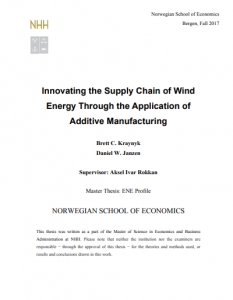Full Title: Innovating the Supply Chain of Wind Energy Through the Application of Additive Manufacturing
Author(s): Brett C. Kraynyk and Daniel W. Janzen
Publisher(s): Norwegian School of Economics
Publication Date: December 1, 2017
Full Text: Download Resource
Description (excerpt):
3D Printing, more commonly known today as Additive Manufacturing, is an industry
that is growing at tremendous rates, with a forecasted market size of over $20 Billion
USD within the next 3 years. Firms like Ford Motor Company, Boeing, Airbus, Lotus,
BAE, Maersk, and General Electric are already using Additive Manufacturing
technology in their manufacturing processes, in applications such as creating molds for
casting, and rapid prototyping. Additive Manufacturing stands to create numerous
benefits over traditional production processes, and as the industry matures, we will see it
become more prevalent in various aspects of our lives. When looking to the energy and
environmental sector, studies say that an expected 10% of oil & gas companies will have
adopted Additive Manufacturing by 2019. However, the wind power sector presents
another opportunity, maybe not yet tapped, to utilize this technology to manage their
supply chain better, gain better control of production processes, and most importantly,
cut costs and speed up time to market with new designs. The question at hand was,
“Does Additive Manufacturing have the potential to contribute to lowering the cost of
wind energy through aiding innovation in the wind power sector and/or lowering the cost
to produce wind energy”? To answer this question, we aimed to determine the feasibility
of producing various components of a wind turbine through the Additive Manufacturing
process. After careful consideration, it was determined that the greatest opportunity
would be to pursue the production of turbine blades. Additive manufacturing provides
the opportunity to produce lightweight components, reduce manufacturing lead times,
and decrease material wastage in the manufacturing process. The primary aim of this
project was to determine a method to reduce overall turbine costs, however, several
additional supply chain and logistics benefits were derived along the way. Through
extensive cooperation with a variety of industry experts, this study was able to determine
that a cost reduction was most feasible by leveraging Additive Manufacturing to produce
molds for turbine blades. This would have a significant impact on reducing overall
throughput time from design to production, will reduce overall turbine blade costs, and
will enable turbine manufacturers to vertically integrate, by either owning processes that
were traditionally outsourced, or by removing costly and time-consuming productions
steps altogether.
